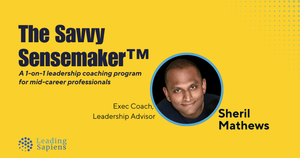If you're on this page, you're likely considering leadership coaching. Below, I'll address some key challenges mid-career professionals face, why conventional approaches often miss the mark, and how my leadership coaching program — the savvy sensemaker — creates the leverage you're looking for.
If any of this resonates, set up a strategy call with me so we can dive into further details. Good luck!
Schedule a free strategy call →
A common problem
"I've got an MBA from a top school and crushing my KPIs, so why do I feel like I'm slamming into an invisible wall every time I try to reach the next level?" These were the exact words of frustration and bewilderment, from one of my clients, a manager at a Fortune 500 company.
This is a challenge I've encountered numerous times in my 22+ years as both manager and leadership coach in corporate America.
Most high performers run into this wall at some stage in their career. Where they end up — stuck in a role vs moving up or laterally— depends on whether they correctly diagnose the actual problem and how they go about addressing it.
When ambitious professionals want to level up, they usually do one of two things:
- deepen their functional expertise in strategy, finance, product etc,
- or dabble in surface-level soft skills.
One path sharpens your craft, while the other teaches you to play nicer.
On paper, these credentials — like the expensive MBA or the soft skills course — make sense. But in practice, the results often fall short. The invisible barrier stubbornly persists, holding back even the best.
The truth is, while traditional development tools have their place, they fail to address the core issues that keep people stuck. What are they missing?
Why traditional solutions fall short
A primary reason why traditional development methods are ineffective is because they operate directly at the level of actions to change performance. They try to change your behavior directly and are mostly tactical.

While useful, this ends up being a band-aid approach.
To get different results, you have to shift the focus from downstream behaviors to upstream strategy that addresses how you think, interpret, and react. Because when you see differently, what you do changes automatically.
This notion is well understood and researched in systems thinking. Setbacks like a bad performance appraisal or being passed over for promotions are more like “events” in the systems triangle. That’s what’s visible. What we fail to examine is what ultimately led to it. The behavioral and functional fixes mentioned earlier tend to focus on the level of “patterns”.
But there are deeper levels that produce those patterns and events, and that’s where you also have the most leverage and control.


This is why leadership coaching is fundamentally different. It’s an iterative process that operates at a different level altogether. The gains are made by working directly with your own situation instead of some random cookie-cutter formula that’s removed from your unique context.
Most importantly, it works at increasing “capacity” which happens at the deeper levels of structures, models, and stance where you have the most leverage and potential for impact.
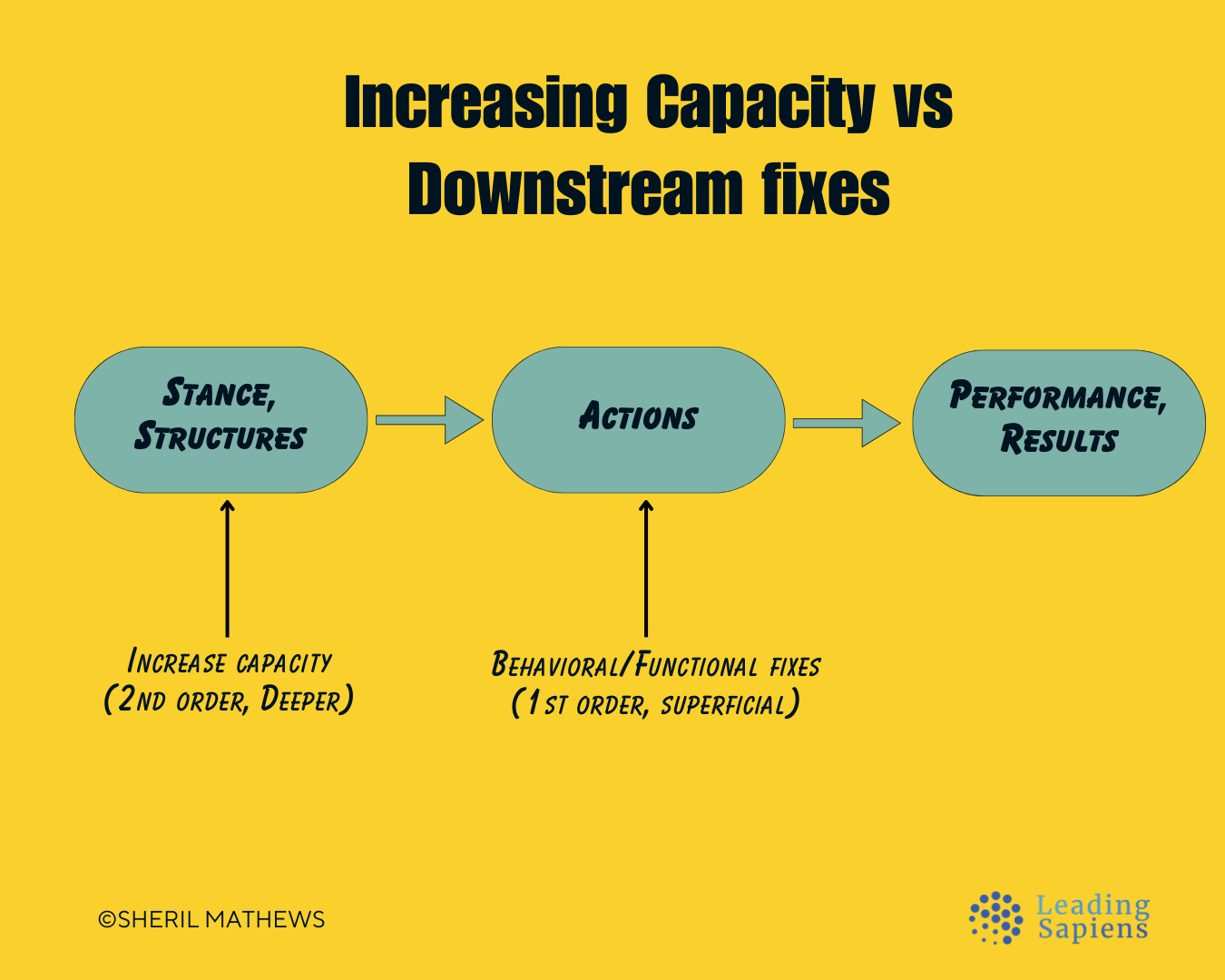
By shifting where we focus, your repertoire of actions and behaviors increases significantly and gives you more control and leverage.
Foundational, not cosmetic
I often use the analogy of a house. Tactics and skills are like furniture and decor. Packaging and presentation while important, are not foundational. They’re visible and improve the look and feel but don't address structural issues.
In contrast, leadership coaching focuses on renovating the underlying structure, rewiring the electrical system, and strengthening the foundation. It's a deeper, transformative process that creates a stable base for sustained growth and adaptation.
At the highest levels, performance isn't just about new tactics. It's about upgrading the thinking infrastructure that produces it in the first place. Not only do you have to act strategically, but also see more strategically. You do that by expanding the frame and understanding what your role actually exists to do. Once that’s done, behaviors shift on their own.
By shifting focus from downstream output to upstream architecture, you learn to play with, not fight against, the forces that are ever present in both your leadership and organization.
If you shouldn’t just focus on tactics, what should you do instead? What does “going upstream” entail?
The three pillars of effective leadership (& successful careers)
Multiple evidence based research studies, and my own observation, show a repeating pattern.
Regardless of title and role, effective leadership (and by extension successful careers) requires mastery of three core fundamentals: skill, savvy, and sensemaking.
- Functional competence is your skill/craft. It's your ability to deliver and execute with precision in your domain. Think finance, strategy, engineering, management etc.
- Organizational savvy is your ability to navigate the messy world of work. It’s about reading power dynamics, managing perception, and influencing across both formal and informal structures.
- Leadership sensemaking is your ability to make sense of complexity. How do you interpret messy, high-stakes situations? Can you reframe them clearly and guide teams toward aligned, confident action? Do you maintain poise under pressure?
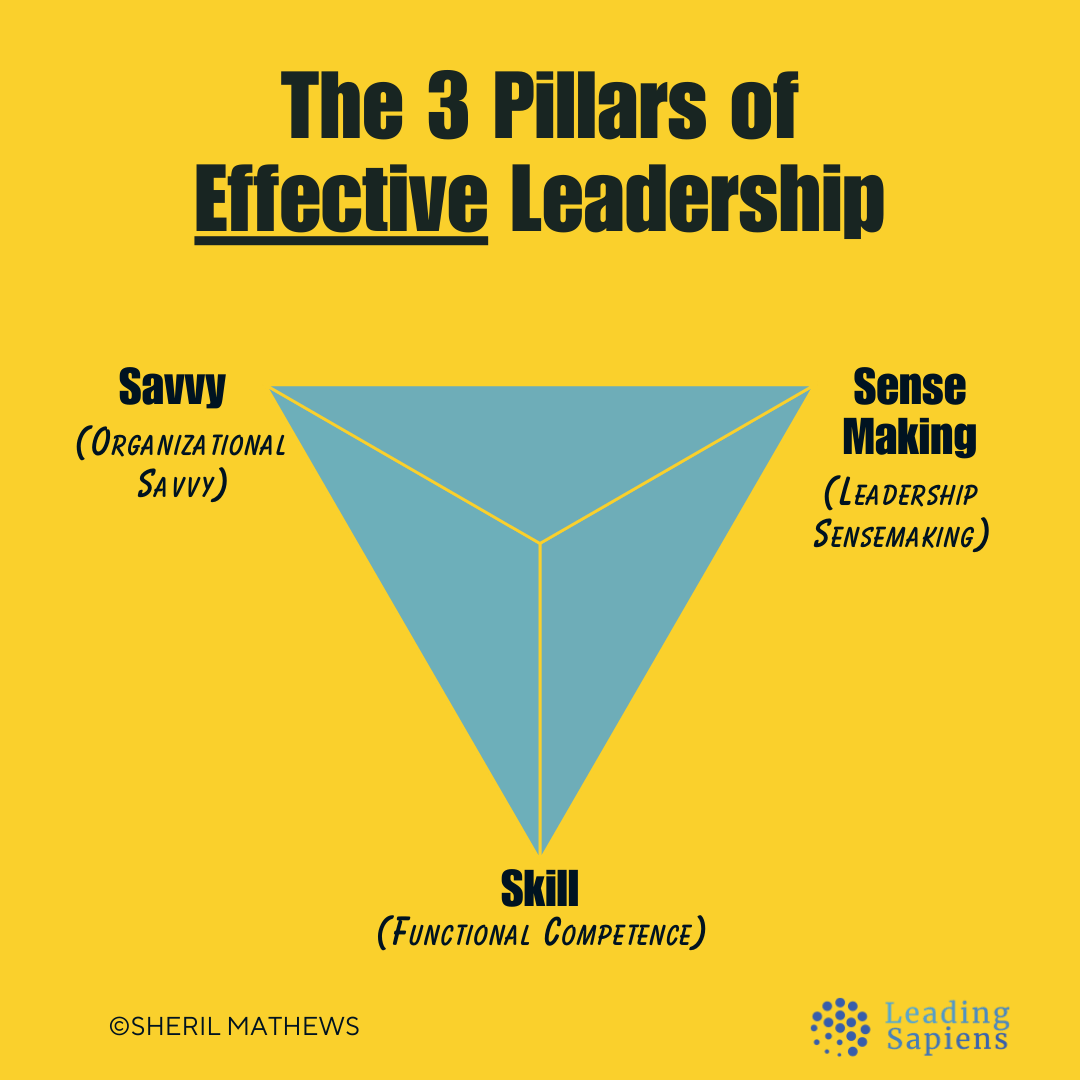
Effective leadership and successful careers are built on these three interlocking capacities. Functional skill earns you a seat at the table. Savvy helps you navigate the dynamics once you're there. Sensemaking is what makes others seek your perspective when complexity demands judgment, not just execution.
Effective leaders — those who succeed in the reality of corporate setups — have a good balance of all three.
Given your performance and where you are in your career, you very likely already have the functional piece down.
Traditional approaches fail because they focus too much on building your functional and technical craft (aka skill) and not enough on either organizational savvy or leadership sensemaking.
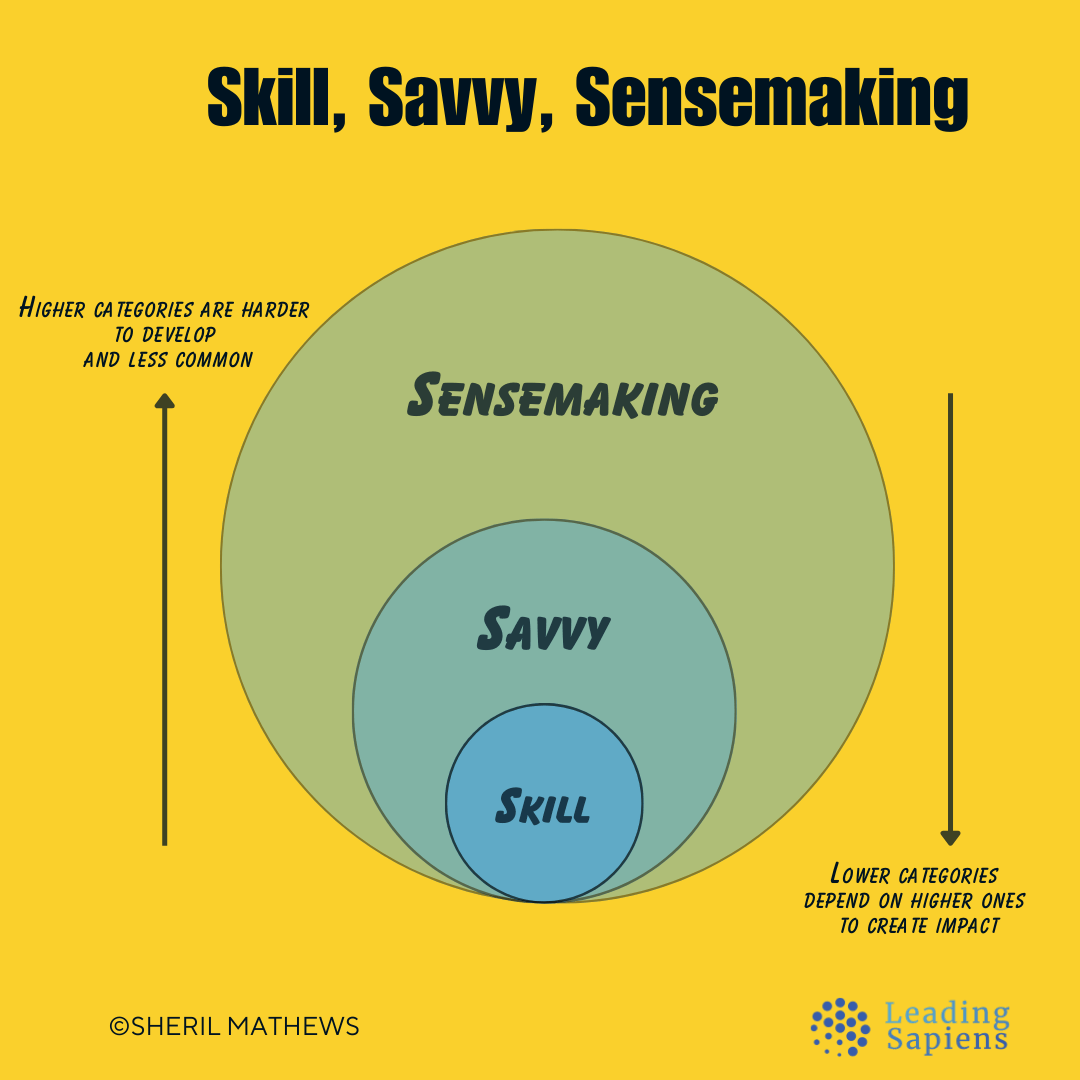
The challenge of increasing role complexity
Further into our conversation, my client reflected, "I know I'm good at what I do. But lately, it feels like I'm playing a game where the rules have suddenly changed, and no one gave me the playbook."
I've heard this consistently through the years. The "game" indeed changes as you rise through the hierarchy:
- Technical competence alone is no longer sufficient.
- Your thinking has to adapt and evolve to match the complexity of your role.
For starters, technical/functional competence is table stakes. It’s necessary, but no longer sufficient. The skills that catapult you to success in early career become less relevant as you climb the ladder.
Most successful folks at mid career are already good at functional competence. It’s the other two critical elements — organizational savvy or leadership sensemaking — that’s often missing.
Not only that, when managing managers or entire divisions, the game fundamentally changes. It’s like going from Newtonian mechanics to Quantum physics. The context becomes increasingly complex, and the patterns harder to discern. Your decisions carry more weight, even as the path forward becomes murkier.
At higher levels people don't fail due to gross incompetence. They falter because the role demands a different way of thinking and operating they were never taught to develop. The role has evolved, but thinking hasn't. Many are “paid to think” but not necessarily trained. They still operate by the same rules and thinking from their IC roles.
It’s like trying to run complex programs on an outdated operating system. Without recognizing this gap – between the demands of the role and how they operate – they remain stuck.
To make things worse, these gaps get misdiagnosed as behavioral issues. "Be more assertive." "You need more executive presence." "Think more strategically." This kind of feedback sounds like guidance, but only end up obscuring the real problem.
No amount of downstream and superficial behavioral tweaking — like charisma or polish — can resolve this gap.
How I Help: The Savvy Sensemaker™ Approach
In our coaching engagement, I start with a deep dive and diagnostic that gets to the crux of what’s holding you back. Based on what we find, our engagement will have a tilt to either organizational savvy or sensemaking. In general, the earlier you are in your career the more you need to focus on building your organizational savvy.
Middle managers and those in later careers often have to focus more on their leadership sensemaking. This is not a given however and why I emphasize diagnostics.
Organizational Savvy: From Smart to Wise
In organizational savvy the goal is to move you into the “wise” zone:
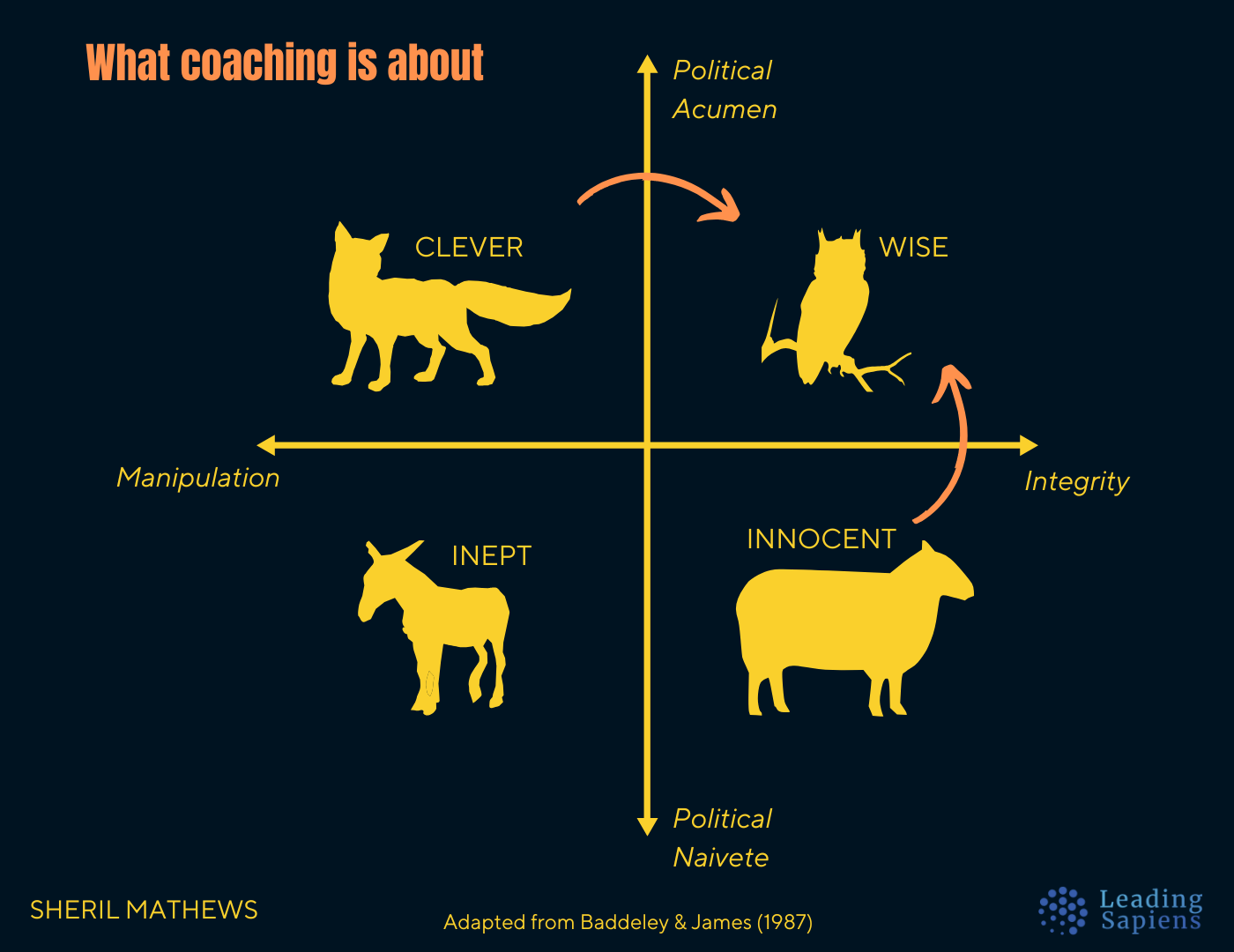
You learn to:
- Navigate power dynamics without cynicism.
- Build influence across hierarchies.
- Manage stakeholders both authentically and strategically.
- Read the unspoken rules that govern your organization.
Leadership Sensemaking: From Doer to Sensemaker
When focusing on leadership sensemaking, the goal is to transform you from being just another high-performing “doer” into an impactful “sensemaker”.
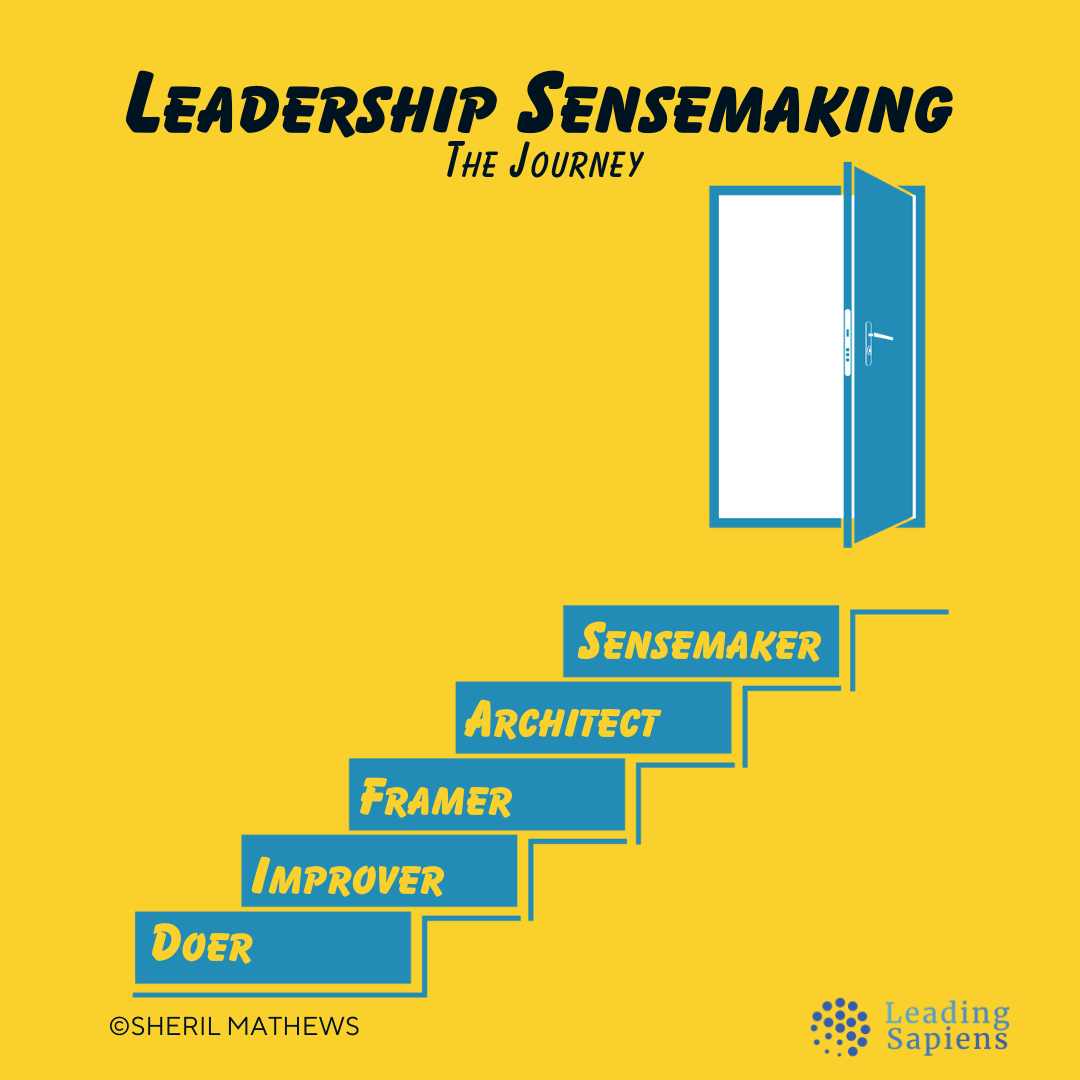
Consider where are you're operating:
- Doer → executing tasks.
- Improver → optimizing performance.
- Framer → shaping how others see the problem.
- Architect → designing upstream conditions.
- Sensemaker → interpreting, orienting, and aligning in complexity.
Most managers are stuck at the doer/improver stages. That’s why they keep hitting the invisible wall. In contrast, the more you operate as an architect and sensemaker, the better your performance as a leader, and the more you stand out.
You develop:
- Upstream thinking that reshapes how problems are framed.
- Judgment that others trust in ambiguous situations.
- Presence that shows clarity under pressure.
Combining sensemaking with savvy is how you break through that invisible barrier. In short, become a savvy sensemaker™ .
While clearly not a silver bullet, leadership coaching is an underutilized superpower that can unlock the next level.
Over 22+ years in corporate leadership and coaching, I’ve developed an entire suite of tools and frameworks to help people build their savvy and sensemaking. The Savvy Sensemaker™ leadership coaching program brings this entire toolkit together into one structured engagement.
Who this is for
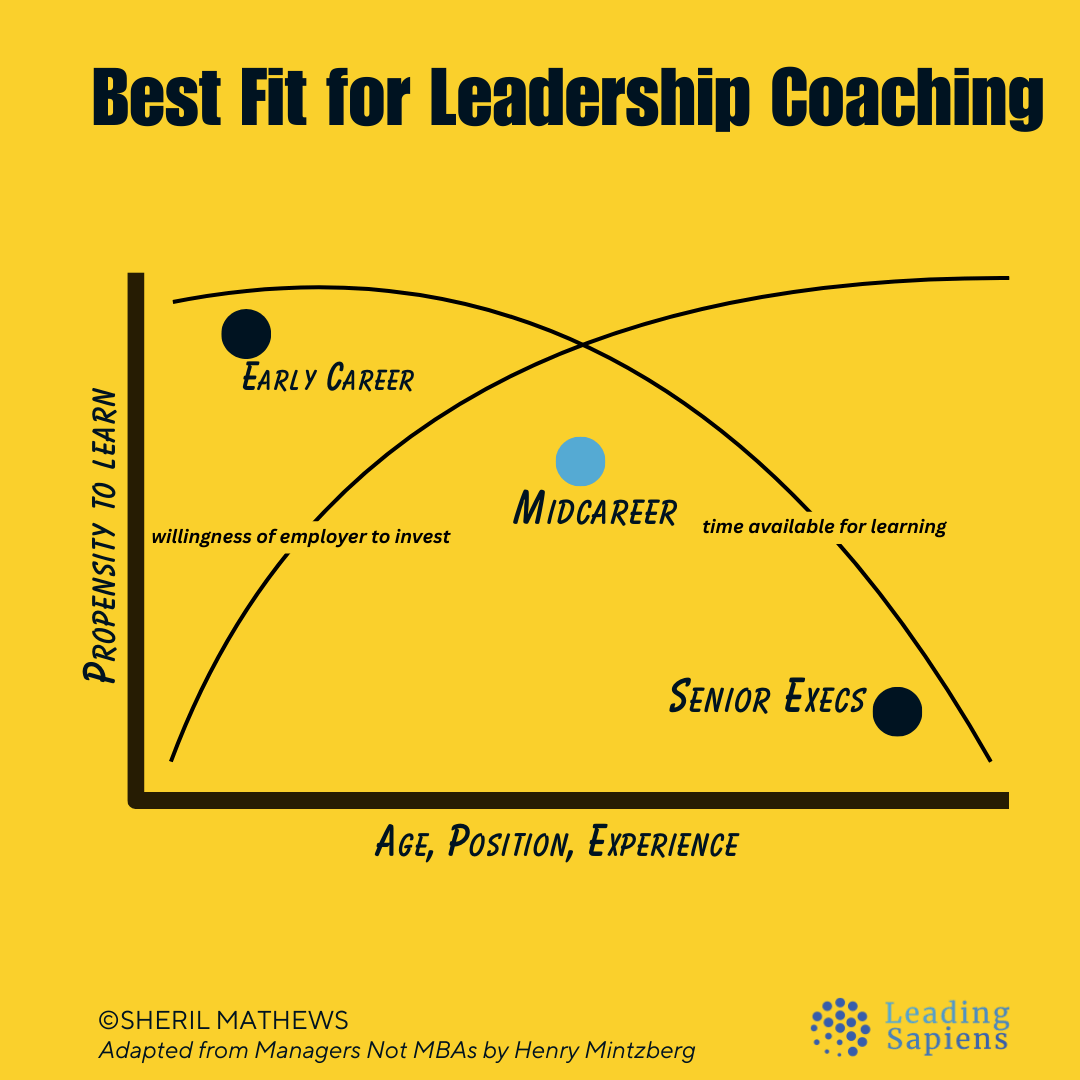
This is a good fit if you:
- Are a mid-career manager, director, or senior IC in a mid-size to large organization.
- Have mastered your functional role but feel stuck hitting an invisible ceiling.
- Tired of vague feedback like "be more strategic" without knowing what that actually means.
- Suspect the real problem isn’t your performance.
- Want practical, evidence-based tools instead of fluff or one person’s opinion.
This is not for you if you:
- Want surface-level tips or expect overnight transformation.
- Are looking for a magic formula rather than do the uncomfortable work of real change.
- Not willing to do the work required to play the long game.
Investment and format
One-on-one leadership coaching is a structured partnership designed to help you see differently and act with more leverage.
Investment:
- $500/month (typical engagement lasts 6 months to several years)
- $5,000/year (when you pay upfront for a 12-month engagement )
Note: these prices are only for my public programs. Corporate coaching programs are priced differently based on package and engagement length.
How it works:
- Format/Delivery. Bi-weekly 60–90 minute coaching calls via Zoom.
- Length of engagement. I recommend at least 6 months. Change takes time, and the compound effect matters more than a quick fix.
- Entry. We begin with a diagnostic intake — a conversation to clarify where you are and what to focus on for leverage. From there, we decide whether you need a tilt more toward sensemaking or organizational savvy. Many leaders need both, but one usually takes priority.
- Between sessions. You’ll get targeted observation exercises, reflection prompts, and reading assignments in between scheduled calls. Full async support via text/email during the length of the engagement. On-call support available for extra.
Start With A Strategy Call
Bring a current challenge: a stakeholder conflict, a promotion you're preparing for, or a role that feels unsteady. In 30-45 minutes, we'll reframe your challenge. You'll leave with clarity and actionable moves, whether we work together or not.
Schedule a free strategy call →
What others have said
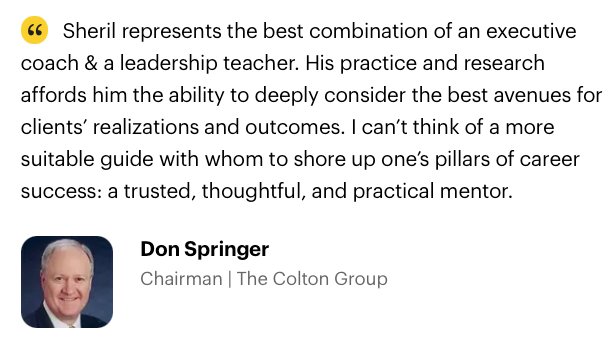
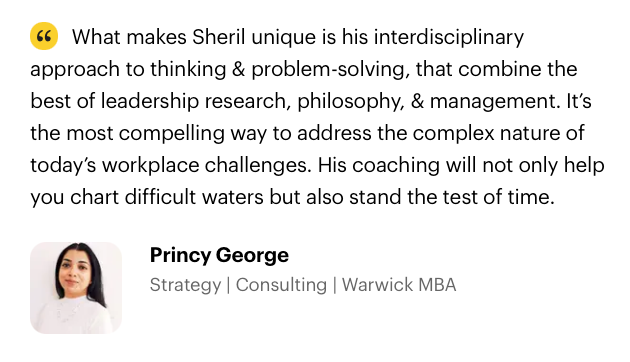

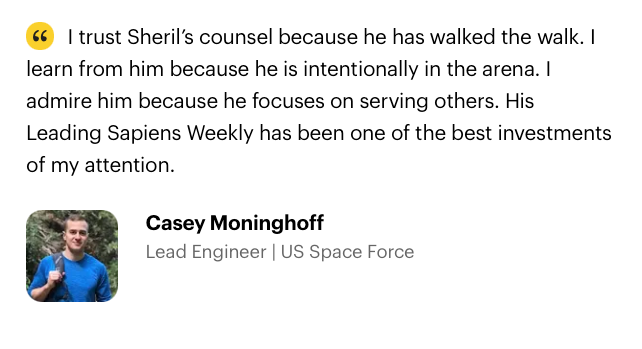
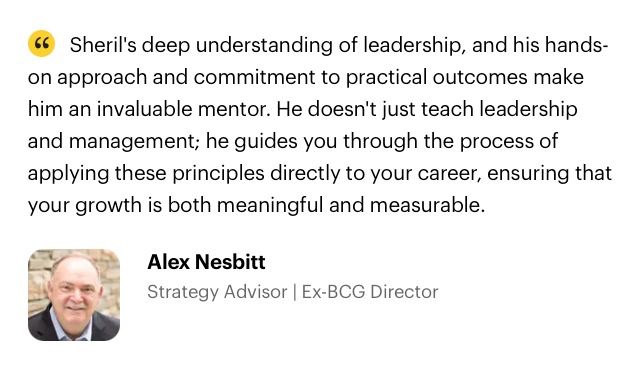
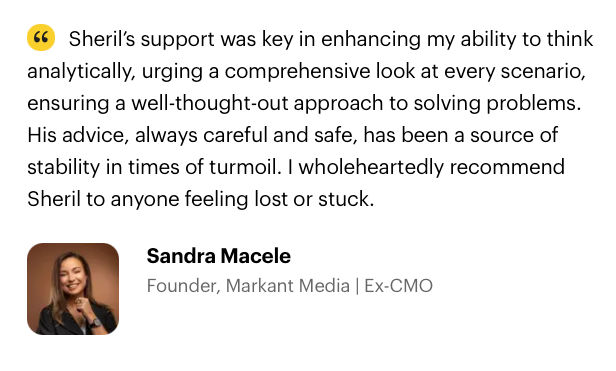

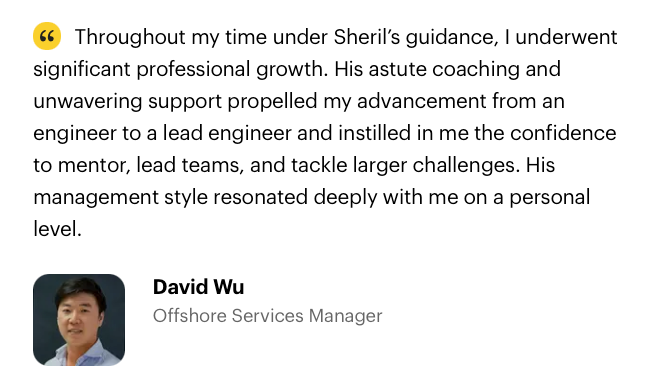
"Six months ago, I was the 'reliable executor', good at delivery but invisible in key discussions. Now I'm the person leadership turns to when they need someone to make sense of complex situations."— Director, Fortune 100
"I used to think politics were toxic and tried to avoid them. Now I understand they're simply part of the operating system. I can navigate influence without losing my authenticity."— VP Operations, Healthcare
"The biggest shift wasn't learning new skills but seeing things differently. Once I understood how to frame problems at the executive level, everything else clicked."— Senior Manager, Financial Services
Results and outcomes
The transformation isn't about learning new tricks or adopting a different "leadership style." It's about upgrading the thinking infrastructure that drives everything else.
The core shift is from downstream tactics to upstream architecture. You stop trying to fix behaviors and start reshaping how you see and interpret situations. Here's what that looks like:
How You Operate
- From reacting to shaping. Meetings stop being exercises in defense. You set the frame and for others to move within.
- From effort to leverage. Same energy, but more impact. You learn to shift context instead of increasing hours.
- From solving problems to setting problems. You become skilled at framing the right questions, instead of just finding answers.
How Others See You
- From reliable to ready. You signal clarity under pressure while others start treating you as next-level-ready.
- From expert to advisor. People seek your judgment, not just technical knowledge.
- From individual contributor to force multiplier. You elevate the thinking of entire teams.
Your Internal Experience
- From wanting certainty to thriving on ambiguity. You're comfortable not having all the answers while maintaining confidence to move forward.
- From anxiety as obstacle to anxiety as information. Discomfort becomes a signal of growth instead of something to avoid.
- From rigid expertise to adaptive wisdom. You know when to apply what you know and when to let it go.
The specific focus depends on where you are:
- By working on organizational savvy: You stop seeing politics as distraction and start seeing influence as part of the real work. You learn to manage up, across, and out without losing authenticity. Your credibility travels beyond your immediate team.
- By working on leadership sensemaking: You stop being told to "be more strategic" and start knowing what that means: framing problems, setting agendas, and clarifying trade-offs. You learn to give direction when the right answer isn't obvious.
Leaders who make these shifts don't suddenly acquire charisma. Instead they start operating from a different vantage point — which changes how they are seen, trusted, and advanced.
Frequently Asked Questions
FAQS
Is this therapy?
No. Therapy looks backward to heal. Coaching looks forward to build capacity. More on differences on this piece on leadership coaching.
Is this training or consulting?
Training transfers content. Consulting gives answers. Coaching works differently — it sharpens how you see, so you operate effectively in your own context.
How soon will I see results?
Small changes often appear within the first few sessions. The deeper ones — judgment, clarity under pressure — take multiple cycles of reflection and practice. That’s why the work unfolds over months, instead of weeks.
What if I already have strong functional skills?
That’s assumed as a given. I don’t coach the basics of your craft. Instead we focus on what’s need to leverage it: sensemaking and savvy. The very things most leaders are never taught.
Will this make me dependent on a coach?
No. The goal is to build your own capacity to self-correct.
Can my company sponsor this?
Yes. Many organizations fund coaching as part of leadership development, high-potential programs, or succession planning.
Ready to break through your invisible ceiling?
You've read this far because something resonated. The question isn't whether you can develop as a leader but whether you're ready to do the work.
Bring a current challenge: a stakeholder conflict, a promotion you're preparing for, or a role that feels unsteady. In 30-45 minutes, we'll reframe your challenge. You'll leave with clarity and actionable moves, whether we work together or not.

